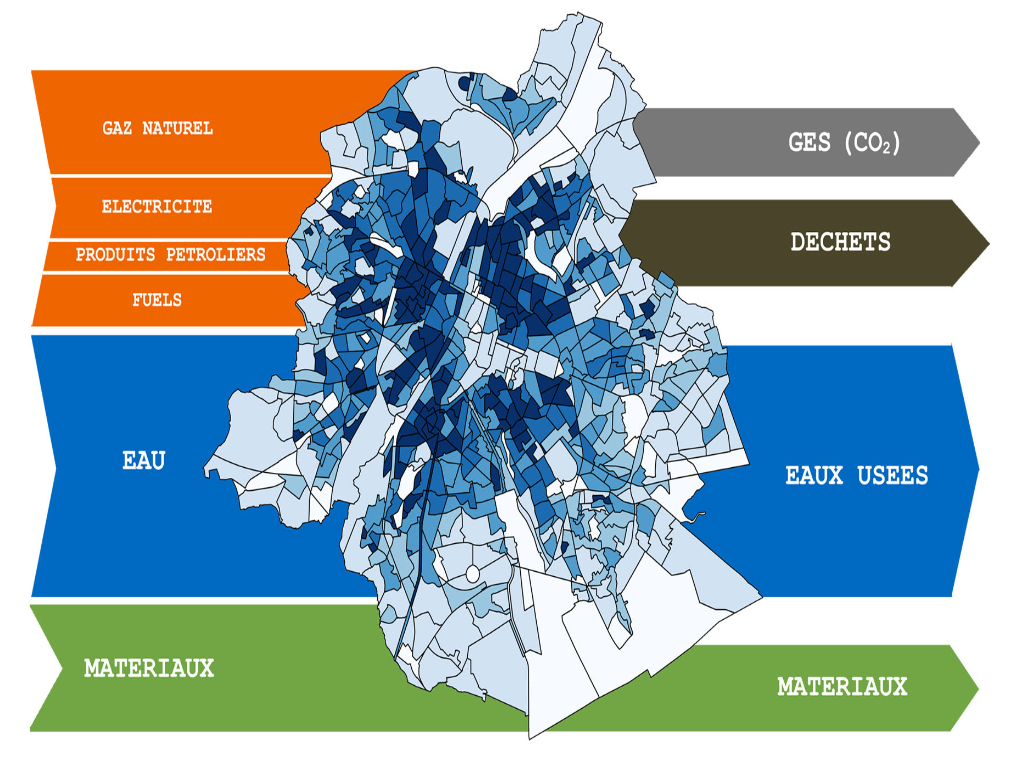Aristide Athanassiadis
Lecturer, aristide.athanassiadis@ulb.be
Collaboration: Philippe Bouillard (ULB), Ahmed Z. Khan (ULB), Robert Crawford (University of Melbourne, Australia)
Keywords: Urban Metabolism, Multi-Scale, Environmentally Extended Input-Output Analysis, Urban Ecosystems, Local Factors, Policy-Making
This research wishes to investigate the complex functioning of urban systems in terms of direct and indirect resource requirements due to their resulting environmental impact. The originality of this work lies in its context-specific and scale- sensitive approach which is achieved by combining a metabolism-based or top-down approach (Urban Metabolism approach) and a consumption-based or bottom-up approach (Environmentally Extended Input-Output Analysis). In practice, this involves performing a material, energy and water balance at multiple spatial scales (metabolism-based approach) as well as a calculation of direct and indirect energy, water and material requirements using household expenditure data (consumption- based approach). In addition, to highlight the importance of context in such environmental assessments, this analysis will be carried out in two very diverse cities in terms of spatial organization and socio-economic patterns, namely Brussels and Melbourne. By correlating the results of this multi-scalar assessment with local factors such as socio-economic (demography, income, household size, GINI, etc.) and territorial organization (density, land use, etc.) indicators a potential identification of drivers with the highest impact will emerge. By estimating the causal relations of how, where and why material, energetic and water flows are consumed it will then become possible illustrate and map the specificity of environmental assessment results for a given socio-economic context and built environment.

Consequently, this multi-scalar and methodologically hybrid analysis will serve as a basis for coherent policy -in fields of production, consumption as well as the efficiency of the built environment itself- which will avoid contradictions, conflicts and obsolescence. Indeed, this complex analysis will attempt to propose policies, plans for actions and environmental awareness at different spatial and administrative levels (region/state, city, municipality, neighbourhood, household) but also for different target audience (governments, grid operators, architects and town planner, neighbourhood organisations, households, etc.).
The research is conducted as a joint-PhD between the Université Libre de Bruxelles and the University of Melbourne.
This research is funded by The Belgian National Fund for Scientific Research F.R.S.-FNRS INNOViris Strategic Platform of Environment: Brussels XL Retrofit (B3 RetroTool project) IBGE-BIM (Urban Metabolism project)
Selected Publications:
[1] Athanassiadis, A. and Bouillard, P. (2013). Contextualizing the Urban Metabolism of Brussels: Correlation of resource use with local factors. In CISBAT 2013. Clean Technology for Smart Cities and Buildings. From Nano to Urban scale. CISBAT, Lausanne.
[2] Athanassiadis, A. (2013). Evaluation of the Urban Metabolism. Data repository and Neighborhood metabolism. Brussels, INNOViris: 30. [3] Athanassiadis, A. (2013). Evaluation of the Urban Metabolism. Scope and purpose definition. Brussels, INNOViris: 23.
Key References
[1] Baynes, T. M. and Bai, X. (2012). Reconstructing the Energy History of a City. Journal of Industrial Ecology. 16(6) 862-874.
[2] Baynes, T. M. and Wiedmann, T. (2012). General approaches for assessing urban environmental sustainability. Current opinion in Environmental Sustainability. 4(4) 458-464.
[3] Baynes, T., Lenzen, M., Steinberger, J. K. and Bai, X. (2011). Comparison of household consumption and regional production approaches to assess urban energy use and implications for policy. Energy Policy. 39(11) 7298-7309.
[4] Kennedy, C., Pincetl, S., & Bunje, P. (2011). The study of urban metabolism and its applications to urban planning and design.Environmental Pollution,159(8), 1965-1973.
[5] Munksgaard, J., Wier, M., Lenzen, M., & Dey, C. (2005). Using Input- Output Analysis to Measure the Environmental Pressure of Consumption at Different Spatial Levels.Journal of Industrial Ecology,9(1-2), 169-185.
[6] Pincetl, S., Bunje, P. and Holmes, T. (2012). An expanded urban metabolism method: Toward a systems approach for assessing urban energy processes and causes. Landscape and Urban Planning. 107(3) 193-202.
[7] Wilson, J., Tyedmers, P. and Spinney, J. E. L. (2013). An Exploration of the Relationship between Socioeconomic and Well-Being Variables and Household Greenhouse Gas Emissions. Journal of Industrial Ecology. 17(6) 880-891.